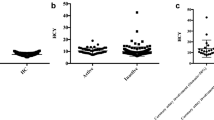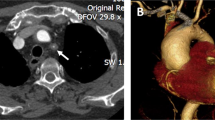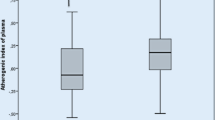Abstract
Our study aimed to determine whether proatherogenic lipid profiles exist in patients with active Takayasu arteritis (TA) and assess the relationship between different lipid profiles and disease activity in TA. A total of 132 premenopausal female patients with TA and 100 sex-, age-, and body mass index-matched healthy controls were included in our study. The clinical data were collected in detail from all participants. Patients with active TA had significantly lower levels of apolipoprotein A1 (apoA1) (1.47 ± 0.30 vs. 1.99 ± 0.33 mmol/L, p < 0.001) and lower levels of high-density lipoprotein cholesterol (HDL-C) (1.23 ± 0.33 vs. 1.68 ± 0.38 mmol/L, p < 0.001) than patients with inactive TA. However, they had higher ratios of apolipoprotein B (apoB)/apoA1 (0.74 ± 0.27 vs. 0.48 ± 0.14, p < 0.001) compared with patients with inactive TA. Multiple linear regression analysis demonstrated that the apoB/apoA1 ratio was independently associated with TA activity (β = 0.38, p = 0.04). In addition, multivariate stepwise forward regression analysis showed that the apoB/apoA1 ratio was the major determinant for high-sensitivity C-reactive protein (β = 0.58, p = 0.002). Our findings indicate that patients with active TA had proatherogenic lipid profiles. In addition, the ratio of apoB to apoA1 could be used as a marker for monitoring and targeting patients with TA.
Similar content being viewed by others
References
Subramanyan R, Joy J, Balakrishnan KG (1989) Natural history of aortoarteritis (Takayasu’s disease). Circulation 80:429–437
Park KC, Kim JH, Yoon SS, Heo SH (2008) Takayasu’s disease presenting with atherothrombotic ischaemic stroke. Neurol Sci 29:363–366
Seyahi E, Ugurlu S, Cumali R, Balci H, Seyahi N, Yurdakul S et al (2006) Atherosclerosis in Takayasu arteritis. Ann Rheum Dis 65:1202–1207
Numano F, Okawara M, Inomata H, Kobayashi Y (2000) Takayasu’s arteritis. Lancet 356:1023–1025
Raninen RO, Kupari MM, Hekali PE (2002) Carotid and femoral artery stiffness in Takayasu’s arteritis. An ultrasound study. Sacnd J Rheumatol 31:85–88
Park SH, Chung JW, Lee JW, Han MH, Park JH (2001) Carotid artery involvement in Takayasu’s arteritis: evaluation of the activity by ultrasonography. J Ultrasound Med 20:371–378
de Carvalho JF, Bonfá E, Bezerra MC, Pereira RM (2009) High frequency of lipoprotein risk levels for cardiovascular disease in Takayasu arteritis. Clin Rheumatol 28:801–805
Arend WP, Michel BA, Bloch DA, Hunder GG, Calabrese LH, Edworthy SM et al (1990) The American College of Rheumatology 1990 criteria classification of Takayasu arteritis. Arthritis Rheum 33:1129–1134
Hata A, Noda M, Moriwaki R, Numano F (1996) Angiographic findings of Takayasu arteritis: new classification. Int J Cardiol 54(Suppl):S155–S163
Kerr GS, Hallahan CW, Giordano J, Leavitt RY, Fauci AS, Rottem M et al (1994) Takayasu arteritis. Ann Intern Med 120:919–929
Expert Panel on Detection, Evaluation, and Treatment of High Blood Cholesterol in Adults (2001) JAMA 285:2486–2497
Tani S, Saito Y, Anazawa T, Kawamata H, Furuya S, Takahashi H et al (2011) Low-density lipoprotein cholesterol/apolipoprotein B ratio may be a useful index that differs in statin-treated patients with and without coronary artery disease: a case control study. Int Heart J 52:343–347
Kim SW, Jee JH, Kim HJ, Jin SM, Suh S, Bae JC et al (2013) Non-HDL-cholesterol/HDL-cholesterol is a better predictor of metabolic syndrome and insulin resistance than apolipoprotein B/apolipoprotein A1. Int J Cardiol 3:2678–2683
Sierra-Johnson J, Fisher RM, Romero-Corral A, Somers VK, Lopez-Jimenez F, Ohrvik J et al (2009) Concentration of apolipoprotein B is comparable with the apolipoprotein B/apolipoprotein A-I ratio and better than routine clinical lipid measurements in predicting coronary heart disease mortality: findings from a multi-ethnic US population. Eur Heart J 30:710–717
Mattsson N, Magnussen CG, Rönnemaa T, Mallat Z, Benessiano J, Jula A et al (2010) Metabolic syndrome and carotid intima-media thickness in young adults: roles of apolipoprotein B, apolipoprotein A-I, C-reactive protein, and secretory phospholipase A2: the cardiovascular risk in young Finns study. Arterioscler Thromb Vasc Biol 30:1861–1866
Paradis ME, Badellino KO, Rader DJ, Deshaies Y, Couture P, Archer WR et al (2006) Endothelial lipase is associated with inflammation in humans. J Lipid Res 47:2808–2813
de Carvalho JF, Borba EF, Viana VS, Bueno C, Leon EP, Bonfá E (2004) Anti-lipoprotein lipase antibodies: a new player in the complex atherosclerotic process in systemic lupus erythematosus? Arthritis Rheum 50:3610–3615
Khovidhunkit W, Kim MS, Memon RA, Shigenaga JK, Moser AH, Feingold KR et al (2004) Effects of infection and inflammation on lipid and lipoprotein metabolism: mechanisms and consequences to the host. J Lipid Res 45:1169–1196
Dullaart RP, Perton F, Kappelle PJ, de Vries R, Sluiter WJ, van Tol A (2010) Plasma lecithin: cholesterol acyltransferase activity modifies the inverse relationship of C-reactive protein with HDL cholesterol in nondiabetic men. Biochim Biophys Acta 1801:84–88
Faggiano A, Pivonello R, Spiezia S, De Martino MC, Filippella M, Di Somma C et al (2003) Cardiovascular risk factors and common carotid artery caliber and stiffness in patients with Cushing’s disease during active disease and 1 year after disease remission. J Clin Endocrinol Metab 88:2527–2533
Sniderman AD (2005) Apolipoprotein B versus non-high-density lipoprotein cholesterol—and the winner is…. Circulation 112:3366–3367
Faraj M, Messier L, Bastard JP, Tardif A, Godbout A, Prud’homme D et al (2006) Apolipoprotein B: a predictor of inflammatory status in postmenopausal overweight and obese women. Diabetologia 49:1637–1646
Onat A, Can G, Hergenç G, Yazici M, Karabulut A, Albayrak S (2007) Serum apolipoprotein B predicts dyslipidemia, metabolic syndrome and, in women, hypertension and diabetes, independent of markers of central obesity and inflammation. Int J Obes 31:1119–1125
Seko Y (2007) Giant cell and Takayasu arteritis. Curr Opin Rheumatol 19:39–43
Walldius G, Jungner I, Aastveit AH, Holme I, Furberg CD, Sniderman AD (2004) The apoB/apoA-I ratio is better than the cholesterol ratios to estimate the balance between plasma proatherogenic and antiatherogenic lipoproteins and to predict coronary risk. Clin Chem Lab Med 42:1355–1363
Blum A, Shamburek R (2009) The pleiotropic effects of statins on endothelial function, vascular inflammation, immunomodulation and thrombogenesis. Atherosclerosis 203:325–330
Acknowledgments
This study is upported by the National Natural Science Foundation of China (grant no. 81170285) and the Research Fund for the Doctoral Program of Higher Education of China (grant no. 20101106110012).
Disclosures
None.
Author information
Authors and Affiliations
Corresponding author
Rights and permissions
About this article
Cite this article
Wang, X., Chen, B., Lv, N. et al. Association of abnormal lipid spectrum with the disease activity of Takayasu arteritis. Clin Rheumatol 34, 1243–1248 (2015). https://doi.org/10.1007/s10067-014-2819-4
Received:
Revised:
Accepted:
Published:
Issue Date:
DOI: https://doi.org/10.1007/s10067-014-2819-4




